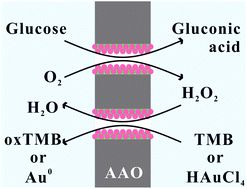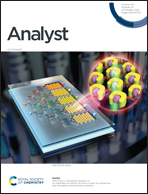In situ growth of nano-gold on anodized aluminum oxide with tandem nanozyme activities towards sensitive electrochemical nanochannel sensing†
Abstract
Electrochemical nanochannel sensors have attracted extensive interest due to their potential applications in biosensing systems. In this work, porous anodized aluminum oxide (AAO) nanochannels are coupled with gold nanoparticles (AuNPs) through a polydopamine (PDA)-induced in situ growth process. It is found that the resulting hybrid nanochannel (denoted as Au-PDA-AAO) can act as both glucose oxidase- and peroxidase-like nanozymes to catalyze the cascade reaction involving glucose. To the best of our knowledge, this is the first report on the synthesis of nanozymes in an AAO nanochannel. Moreover, apart from the nanozyme-catalyzed colorimetric reaction, the Au-PDA-AAO nanochannel could simultaneously serve as a sensitive signal reporter for an electrochemical sensing platform. In such an approach, the glucose oxidation reaction boosts the resistance of the Au-PDA-AAO nanochannel towards ion transport based on the H2O2-mediated size enlargement of AuNPs, resulting in the varied transmembrane ionic current signal of the Au-PDA-AAO nanochannel. On the basis of the changed current–potential properties, the label-free detection of glucose can be achieved with a low detection limit, good reproducibility, and high stability. This work demonstrates the feasibility of the incorporation of versatile nanozymes into AAO nanochannels for mimicking multi-enzymatic catalysis reactions and detecting target analytes.



 Please wait while we load your content...
Please wait while we load your content...